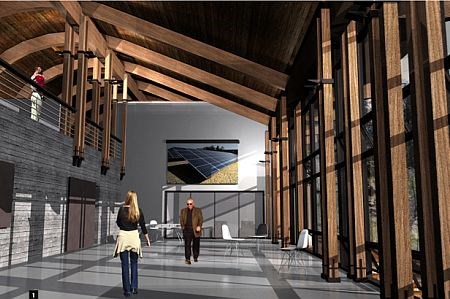After years of discussion, planning and false starts, Sudbury’s Cambrian College is finally looking to make its $6-million Xstrata Nickel Sustainable Energy Centre a reality in the spring of 2010.
The ambitious 9,000-square-foot facility, to be located on school grounds, will go to tender by winter in the hopes of being able to break ground in April with a completion date set for the fall of 2011.
“There’s nothing out there that’s ever been done like this,” says Sylvia Barnard, president, Cambrian College.
“When you’re on the leading edge this way, it takes time, and it’s taken a little more than we initially anticipated, but we’re off and running now.”
As a technology showcase and learning centre for the school’s Energy Systems Technology students, the Sustainable Energy Centre is being designed as a “Living Building,” meaning it will exceed values of LEED Platinum. It will follow extremely stringent criteria laid out by the Seattle-based Cascadia Group, headed up by former Sudburian, Jason McLennan. The criteria dictates that the building has as light an impact on the environment as possible.
Rather than taking a standard building approach and simply adding “green” elements to the design, the Living Building requires an entire rethinking about how the entire building process is approached.
This means using as much locally-sourced and recycled material as possible, thereby reducing the amount of fuel consumption required to transport them to the site. These restrictions have already begun to pose some problems, forcing officials to rethink plans to source sizeable wooden beams from British Columbia.
It will explore the potential of using a variety of sources to produce power and heat, including wind, solar, geothermal and biomass technologies. If successful, the project will be independent from the grid, producing more power than it consumes.
Other features will include composting toilets and a “green roof,” where a plant cover helps to absorb solar energy rather than have it sink into the building and require additional cooling.
These and other measures had to be drawn from scratch, as there are no existing Living Buildings to act as examples. Cambrian’s project has the potential to be the first Living Building in North America, and is in competition with three other facilities in Victoria, in Seattle and on the United States’ East Coast.
“It is pushing the envelope in every single way we think about buildings,” says Barnard.
In advance of the project, Cambrian has already completed construction on the first set of “living labs,” including a pair of 10-foot-by-10-foot miniature homes.
This includes the “Northern Ontario” lab, which replicates a standard home in terms of its use of inefficient appliances, windows and heating systems. It sits next to the similarly-sized “Super North” lab, which makes use of triple-paned and triple-glazed windows, new and high-efficiency appliances, as well as an efficient ventilation system.
A test pad for solar panels has also been built, with the installation of solar technology expected to begin through the year. All three elements will allow students to apply a variety of materials and techniques in order to gather data and determine how different products work in practical applications.
Three additional living labs will be built once construction on the Sustainable Energy Centre is underway, likely in the summer or fall of 2010.
Both the labs and the centre will serve as a showcase for new products and technologies for the public, and a partnership has been struck with Science North to create interactive displays.
They will also provide local businesses and technological engineers opportunities to test materials and prototypes in a real-world setting.
Being able to offer this type of opportunity is important for helping Northern Ontario to develop and strengthen its own green-energy industry, according to Kristopher Stevens, executive director of the Ontario Sustainable Energy Association.
“We wholeheartedly applaud these kinds of projects, and the one that Cambrian is working on is impressive,” he says. “We’re excited to see these kinds of things taking place in Northern Ontario.”
www.cambriancollege.ca




